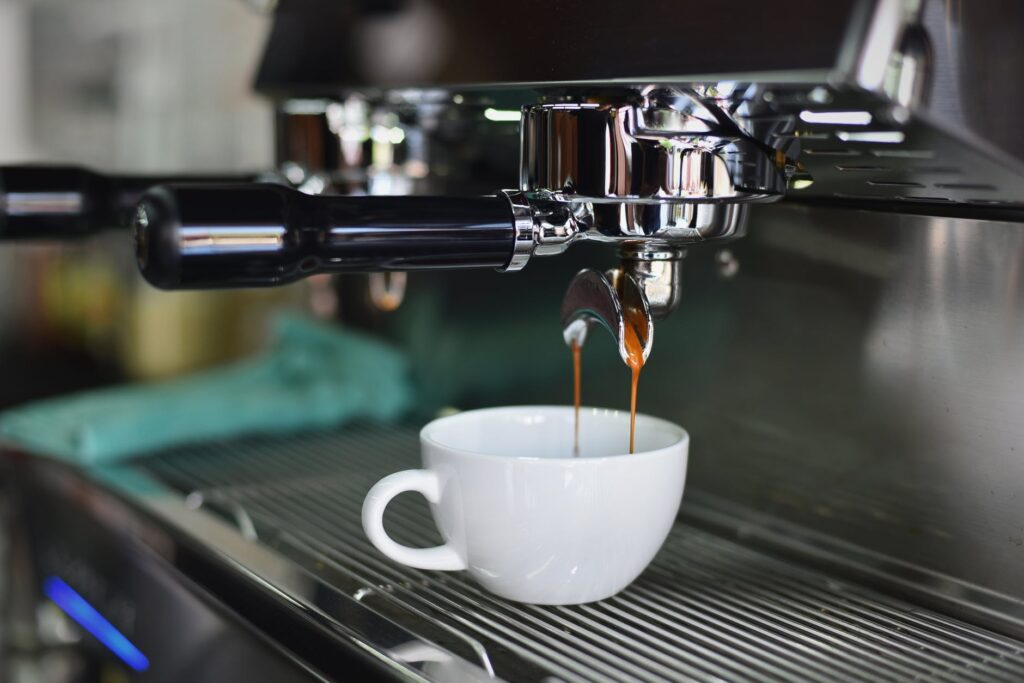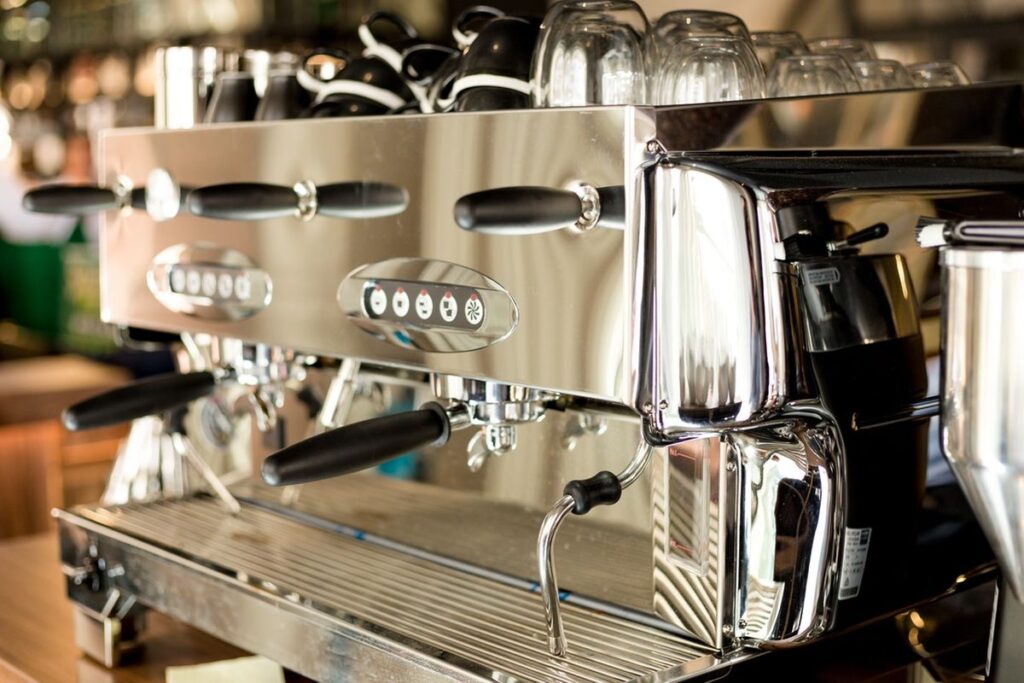Espresso got its name not only because you’re “expressing” the flavor out of coffee, but also because you’re doing it fast. In a large household or in a business environment it’s crucial to have a machine that’ll withstand all the pressure (pun intended).
While preparing this article, we tested 33 products to select the 7 best espresso machines under $1000. From such expensive machines, we expected that they’re ready for heavy-duty environments. Thus, we looked for machines that have a power of at least 1200W, so that they’re ready for a lot of work. We also selected machines that have a big enough hopper capacity, since refilling it frequently is quite annoying. Our Editor’s Choice is the Breville Barista Touch thanks to its superb specifications and all-around capabilities.
More features: 5 programs, 8 coffee settings, programmable milk temperature, touch screen, BPA free water tank
Nothing brings great quality espresso right inside your home better than Breville Barista Touch. This espresso machine comes in two finish options, brushed stainless steel and Black Truffle, both of which add to its aesthetically defined appearance. Measuring only 14.5″ x 16.7″ x 17.6″, it’s a compact unit that can fit into a myriad of spaces in the kitchen.
Intuitive touch-screen display and operation means you can customize your preferred coffee settings and get your brew ready faster than ever. The machine comes with 5 pre-set coffee menus, delivering excellent blend and taste in just seconds. In addition, you can store up to 8 coffee settings, eliminating the need to change the settings every time you want to prepare your favorite espresso.
The 67 oz water tank stores enough water to make 8 cup volumes before refilling, and with a ThermoJet heating system that reduces heat-up time to only 3 seconds, there is virtually no wait time when it comes to getting your espresso.
Other impressive features are an auto steam wand that allows you to adjust milk temperature and texture, an efficient built-in grinder and grinding cradle that allows you to grind directly into the portafilter, PID digital temperature control technology that keeps the temperature constant during extraction, and a 2-year repair guarantee.
More features: LCD, 6 drinks option, 5 grinder settings, 16.9 oz milk carafe capacity, automatic rinsing cycle, pre-brewing system
The Gaggia Anima gives you the option to use either whole beans or pre-ground coffee for your brews, with a pre-brewing system delivering the perfect taste in each espresso serving. It works by maintaining a slight pause between when the water hits the beans and when the brewing starts. This slight delay ensures optimal soaking of flavor.
Another cool feature is the automatic cleaning system, a rinsing cycle that is activated immediately you switch the machine on or off. This ensures you get an unadulterated aroma and taste at each extraction. Likewise, there’s a special milk circuit quick clean system that allows you to clean the milk circuit after preparing a milk-based espresso. An integrated double chamber milk carafe makes it possible for you to prepare your favorite espresso with milk options fast and easy.
A simple interface complemented by an LCD screen makes it easy for you to adjust your settings. Choose from 6 program settings and 5 grinder options and adjust the temperature to one of the three supported levels. The brew group is removable, an option that allows for thorough cleaning.
We noticed that the water light sometimes comes on even when you have sufficient water in the tank, and when this happens, the machine stops brewing. Adding water solves the problem, but the brewing process restarts from the beginning. Can get you frustrated when you’re in a rush.
More features: digital temperature control, hands-free operation, adjustable grind amount, automatic water temperature adjustment
Breville the Barista is a good choice for homes or small offices where several people will be using the espresso machine every day. With a water tank capacity of 67 oz, it will be several espresso shots before you refill the water.
The built-in grinder in the Breville the Barista delivers just the right amount of coffee beans for the type of drink you’re brewing. Adjust the settings accordingly for a single shot or double shot. To ensure maximum extraction and a rich flavor, a digital temperature control system keeps the water hitting the beans at optimal temperature.
The settings allow you to control the grind amount and, in this way, control how strong your espresso is. You can also adjust the grind size using the grind size dial to get a finer or coarser grain.
This machine comes with a range of accessories that many coffee lovers will love. In addition to the scoop and tamper, you also get a razor dose trimming tool, a milk jug, cleaning tablets, cleaning brush, tool and Allen key, and water filter and water filter holder.
We were overall satisfied with the performance of this espresso machine. However, we noticed that each time we switched it on, there would be an unusual noise coming from the grinder. This didn’t have any bearing on the machine’s performance so we don’t know what to make of it yet.
More features: 10 pound weight, flow stop, automatic shut-off function, automatic cleaning system, 19 bar pump pressure
The first thought that comes to mind upon using the De’Longhi Nespresso Lattissima for the first time is that it was meant to get rid of all the hard work in making espresso. The process is straightforward and the machine works fast. Just load the capsule into the machine, choose your settings, push the button and it quickly dispenses your espresso before ejecting the capsule.
Thermoblock heating system heats-up the machine rapidly, reducing the wait time to mere seconds. De’Longhi’s patented extraction process uses 19 bars of pressure to draw the highest flavor concentration while keeping the temperature in each cup optimal. The container comes with 10 capsules so you’ll enjoy quite a few brews before buying additional capsules.
It has 5 preset coffee options and a memory function for 7 options, including hot water. The hot water function is great for when you want to make something other than an espresso. Simply get your hot water from the capsule machine instead of boiling water separately on a different appliance.
For milk-based beverages, the carafe dispenses milk in adjustable levels during the extraction process so you can choose how much milk you want in your drink. The milk carafe has a capacity of 12 oz.
Other great features are the automatic cleaning system, automatic shut-off, and flow stop function. The automated systems make it easy to brew the perfect espresso shot while also reducing any waste. It also comes with a 2-year limited warranty, which means you are guaranteed of always having technical support.
More features: detachable brewing head, 2-in-1 portafilter, up to 10 bar lever pressure
The Flair Signature is a stylish, little manual machine that will add an ornamental touch to your kitchen. It features a detachable head and measures only 12″ x 6″ x 10″ – small enough for you to fit it on a trolley when not in use. It’s constructed wholly from stainless steel and aluminum, durable materials that will see you use this machine for years. The manufacturer gives a 5-year limited warranty, but you’ll likely carry on using this espresso machine long after the warranty period, given the quality of build and materials.
It’s highly portable and weighs only 7 lbs. The only drawback is that you need to buy a burr grinder to grind the beans. You also need to boil water for your espresso separately.
For the best flavor, it is recommended that you grind the beans minutes before brewing. You also need to use rapid boiled water at between 195°F and 205°F. This means you must plan to boil the water and grind the beans when you’re ready to brew. You can’t do it too early as it will affect the flavor of your espresso.
The Flair water cylinder has a capacity of 60ml. You need 13-18 g of coffee and lever pressure of 6 BAR-10 BAR to extract a 45ml shot of espresso. Extraction of one shot takes 30-45 seconds. Not bad for a manually-operated machine.
More features: 15 bar pump pressure, removable drip trail, LED indicators, thermoblock heating system, built-in steamer
The EspressoWorks All-In-One Espresso Machine Set comes with everything you need to brew your favorite brand of espresso, including a plug-in electric grinder, 2 portafilters, stainless steel frothing cup, tamper, measuring scoop, and 2 espresso cups.
Both the espresso machine and grinder connect to 120V power supply. To get a rich flavor,, grind your beans just before brewing. The control dial has three settings: Off, Espresso, and Steam. You can only perform one function at a time, meaning you can’t brew and pour an espresso and steam your milk at the same time. But you can pour two shots at once. In fact, it comes with a single shot filter and a double shot filter.
Although the manufacturer indicates that the machine has a 15 BAR system, the espresso pours slowly as though there isn’t enough pressure. This shouldn’t be a problem if you’re only making one or two shots of espresso. If preparing tens of them, though, the slow process may become irksome.
The water tank has a 42.2 oz capacity, and the best part is that it is transparent, so you can monitor the water level at all times. Should you get distracted and forget to check the water over time, LED indicators will alert you when the level gets low.
It comes with a 1-year limited warranty.
More features: energy-saving mode, 3.6 ft cable, symbol display, TÜV-certified, cleaning programs
For a single user who needs only one shot of espresso to take them through the day, the Jura Ena Micro 1 espresso machine is a charmer that delivers perfectly brewed shots of espresso each single time. The only trouble would be if you like to take your espresso throughout the day. You’ll probably get tired of the constant water refills needed, because the water tank has a capacity of only 38.6 oz. It’s also worth noting that it holds 0.2 lbs of beans at maximum, which is far less than what many espresso machines can hold.
Other than that, there’s plenty of goodness in this little machine, including 2 aroma levels to choose from. That’s right. It brings to life those heavenly coffee aromas you always thought were unattainable. A responsive touch panel makes it easy to operate, and you get 6 settings to customize your espresso brews as you like. The machine has an energy-saving mode and a patented zero-energy switch for enhanced energy efficiency.
With dimensions of 17.5″cx 12.7″ x 9.1″, it is a compact piece that will occupy minimal space, making it ideal even for tiny kitchens. This also means that the machine is quite portable and can easily be transported. It comes with a 2-year limited warranty. This is a great espresso machine that can be used at home, especially for coffee enthusiasts whose first routine in the morning is to brew some coffee. It can also be useful in small businesses or offices where employees and clients are served.
With so many different types of espresso machines, how do you determine which one is ideal for you? In this next section, we seek to make this easy for you to figure out. We explain the various features to consider when choosing an espresso machine, answer a few of the questions you may have about this machine, and give you tips on how to maintain your espresso machine.
Espresso machines under $1,000 generally fall under the low to mid-price range. They won’t come with the bells and whistles found in high-end models, but they’re not stinking of cheapness either. Here’s some of what to expect from such a machine.
Most come with a built-in grinder and this makes using them easier because you don’t have to grind your coffee beans separately. A few will have stand-alone grinders that require you to grind the beans first and transfer them to a portafilter.
Some models come with a steamer and frothing wand for milk preparation, must-have options for those looking to make lattes and other forms of espresso with milk.
Assuming you choose a good quality machine, like the ones we’ve reviewed above, you can expect to use it for years. And with a bit of care, you may even extend its lifespan and delay the onset of mechanical problems associated with normal wear. Here are some tips to help you along:
In the under $1000 category, espresso machines with a higher number of features and advanced built-in technologies cost between $700 and $1000. Those at the mid-price range cost $300-$500, and while they don’t have as many features as the former, they are solidly-built. At the lower end are machines under $300, which we consider affordable. There are some good designs in this category too, and most of them have what it takes to brew fine espresso, as you hope they would.
Let’s address each feature in an espresso machine individually and find out what role it plays in the machine.
There are three main espresso machine types:
The machine of choice for coffee connoisseurs, a manual espresso machine allows you to have full control over the espresso-making process. It doesn’t have automated systems and digital controls. Rather, you determine how you want to make each espresso shot and mix everything manually.
This type is quite expensive compared to the automatic ones, but the machines are well-built and tend to last a long time. They also yield some great-tasting shots if the mixing is done right and most of such machines create convenient ways to achieve that, like Flair Signature.
This type has both manual and electric components, which make it a lot easier to use than a manual espresso machine while giving you some control over the mixing process.
They are also less expensive, with a good number ranging between $200 and $500.
The espresso-making process is fully automated in these machines, and this makes them super easy to use. But it also means you have no control over the shots. While the best of these cost thousands of dollars, you can find some good ones for less than $1,000.
Size is the first thing you should consider when making plans to buy an espresso machine. Do you have enough space in your kitchen for a large machine, or you can only spare a few inches for one? Fortunately, these machines come in a wide range of sizes that make it easy to find one in an appropriate size.
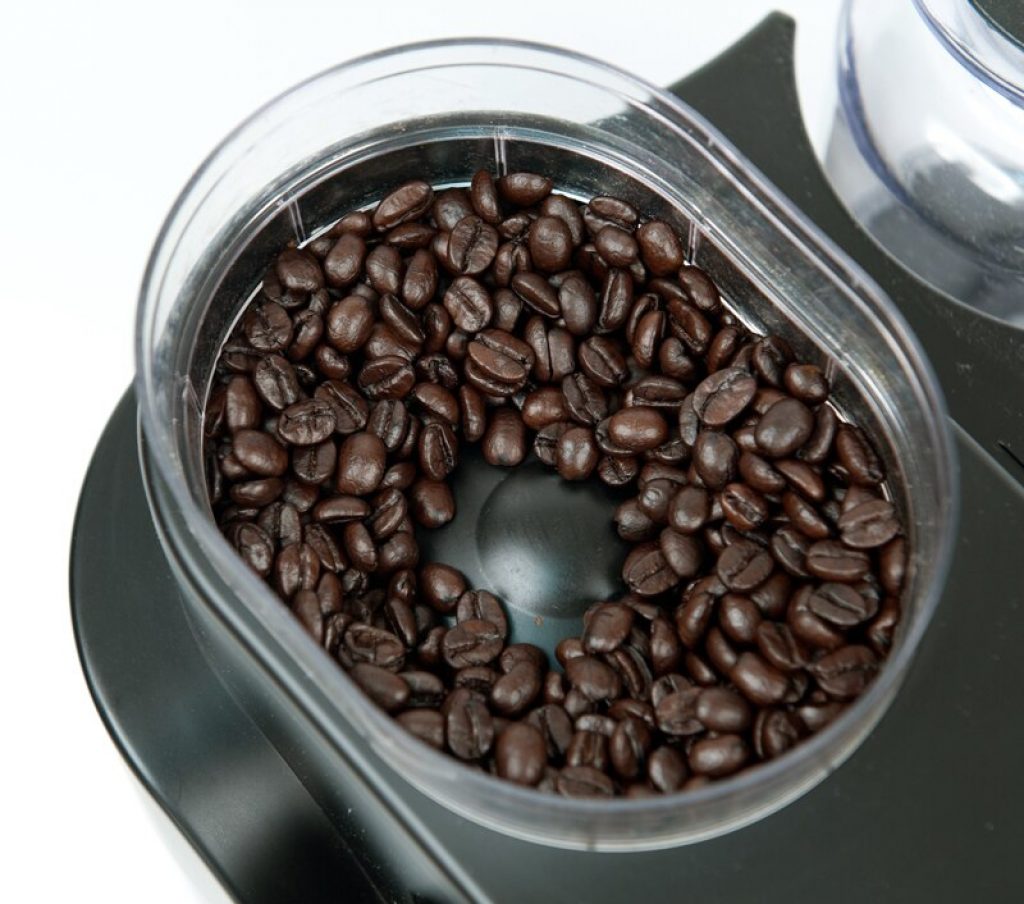
The average capacity for the bean hopper is 0.5 oz, but some will hold a higher or lower quantity of beans. The Jura Ena Micro 1 is an example of a machine with a lower bean capacity, but given that it’s designed to be a single user product, this isn’t a problem. If you have more users or a single heavy user, a lower bean capacity means they have to refill the beans more frequently than they would if the machine had a higher capacity.
Choose between an espresso machine with a built-in grinder or one that uses a separate, stand-alone grinder. Fully-automatic espresso machines come with a built-in grinder, so this is one less detail to worry about. With semi-automatic machines, however, you will have to purchase a grinder. Again, this will require additional space so make sure you have adequate counter space before going for this option.
The best espresso machines have some form of digital temperature control technology at play to help keep the water temperature consistent throughout the brewing process. Fluctuations in water temperature affect the taste of the espresso. If the water hitting the beans has a different temperature at each flow, it will reflect in the flavor. To avoid this, an automatic temperature control system is desirable.
The programming feature allows you to customize the espresso machine as you like. You can control the temperature, choose different descaling options, set the timer, automatically turn the machine on and off, and in the most advanced models, customize these settings for several users. The level of programming and customization varies with each machine, so be clear about the customizations you require and shop with these in mind. Note that the more the programs in an espresso machine, the higher its cost.
Choose between a pressurized portafilter and a non-pressurized portafilter. A pressurized portafilter takes care of tamping and basically makes sure that the consistency is right. With a pressurized portafilter, you’re assured that the flavor of your espresso will be well-balanced, even if you have an average quality grinder. This filtration type is perfect for those who just want to prepare their espresso treat in the fastest, least involving way possible.
With a non-pressurized portafilter, you’re responsible for making sure that the grind-size and consistency are just right, and it’s up to you to ensure that the coffee is perfectly compressed (tamped) in the filter. This option is perfect for those who consider making espresso art and who take pride in getting it right.
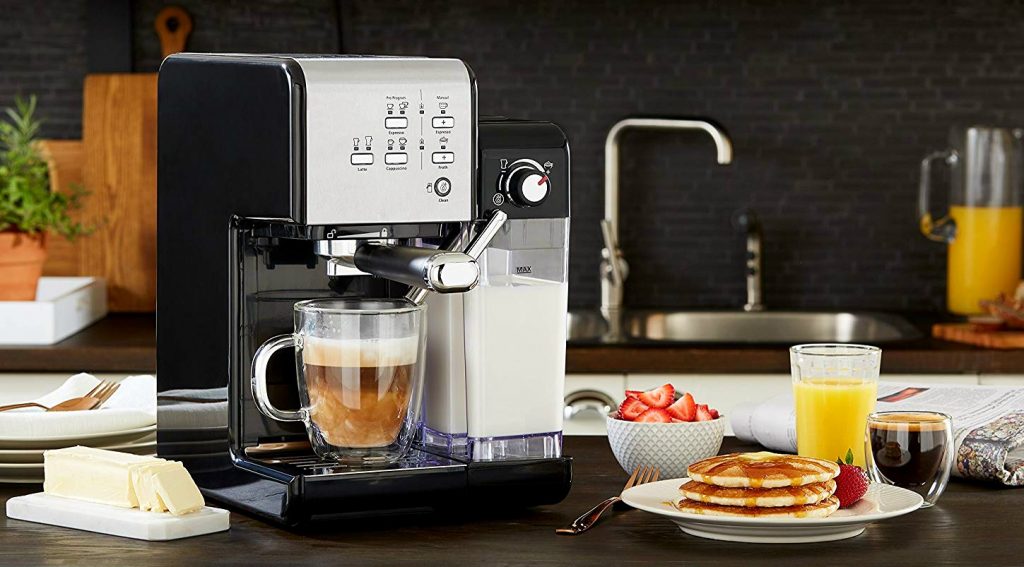
Let’s talk specifically about the espresso extraction time. If you’re trying to calculate how many minutes this would be, you’re way off the mark. Espresso machines are fast. With a 13-18 gram dose of perfectly-ground and tamped coffee, you should have a single shot ready in about 20 seconds. A double shot would take 25-35 seconds at most. Even manual espresso machines like the Flair Signature have an extraction time of only 30-45 seconds.
The entire preparation time will be longer if you factor in bean grinding for machines that don’t have a built-in grinder, like the EspressoWorks All-In-One Espresso Machine Set.
Also known as the drip tray, this is a pan-like or tray component that’s located beneath the portafilter. Its purpose is to catch any overflow or spillage and rinsing water, essentially keeping the machine clean. The best espresso machines have steel drip pans, while the cheaper ones have plastic drip pans.
Empty and clean your drip pan regularly to ensure that there are no bacteria breeding underneath the machine. If you only use the machine occasionally, rinsing the drip pan after every use will ensure this never happens.
Most of the semi-automatic and automatic espresso machines in the under $1000 range come with a 1 or 2-year limited warranty. By contrast, the warranty for manual espresso machines averages 5 years. Understand what’s covered under the warranty to know if you’re getting a good deal, especially if you’re buying a machine that’s on the higher end of the price scale.
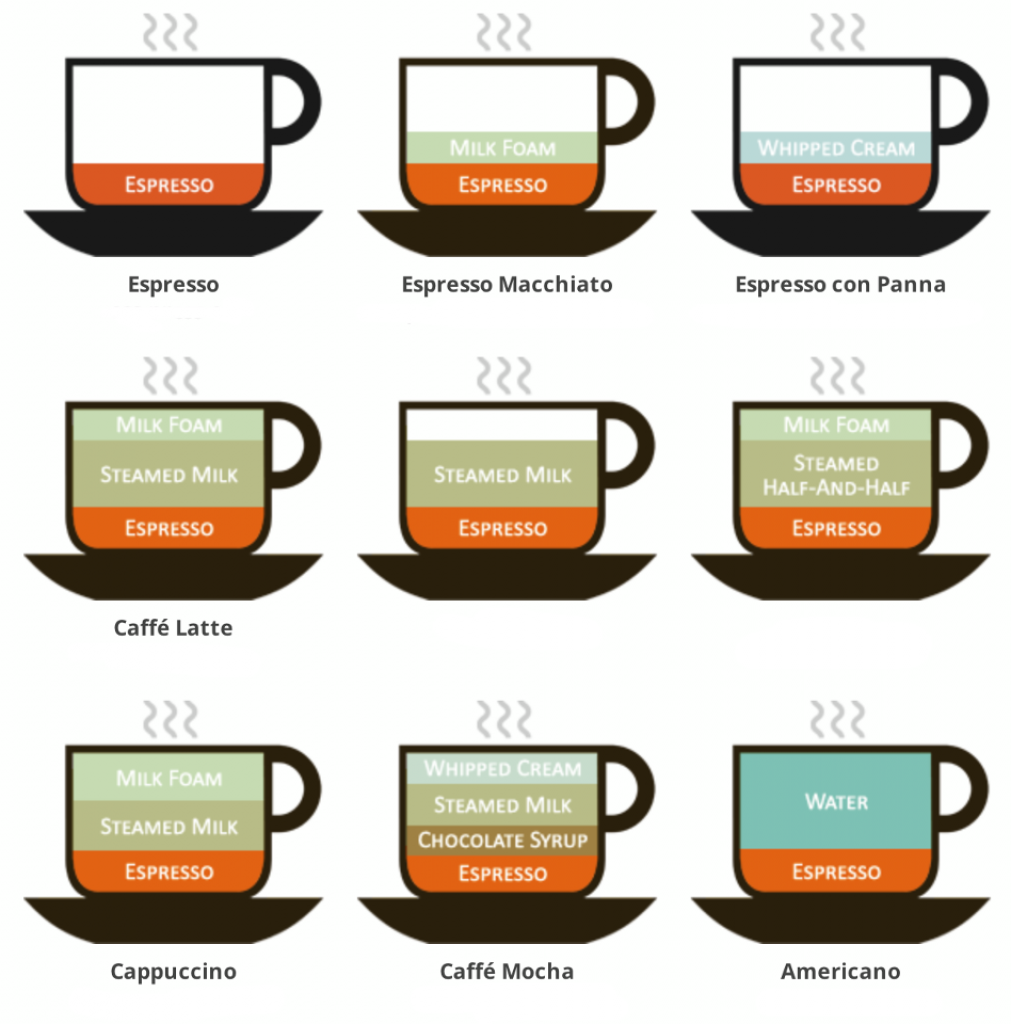
It begins with how you store your coffee. Buy the freshest beans you can find, transfer them to a dry, airtight container, and store away from light to retain freshness.
Experiment with different grind sizes until you find the grind size that yields the optimal extraction time (25-35 seconds). If the extract dribbles out slowly, it means your grind is too fine and you need to adjust to a coarser grade. If it’s too fast, your grind size is coarse, and you need to make it finer. Use a good quality grinder that allows you to make minuscule adjustments to the grind size until you hit the magic size.
For consistency, aim for a dose of 18 grams for each extraction.
The ideal temperature for brewing espresso is 195°F-205°F. Adjust your machine temperature accordingly to attain this range. Depending on the type of boiler the machine uses, this could mean a simple digital reset or flushing technique in a single-boiler.
Once you’ve mastered these, begin to experiment with different variations of each to discover new flavors.
In an espresso machine, a small amount of hot water, near boiling point, is forced through finely-ground coffee beans at high pressure in a process that takes approximately 30 seconds. The resulting extract is thicker and more flavorful than what you get from a coffee maker.
If your water is unfiltered, you should descale every two months or monthly if you use the machine a lot. Most modern espresso machines have an indicator that notifies you when the machine is due for descaling. If yours doesn’t have this indicator, do it monthly or once every two months.
Our top pick in this price category is the Breville Barista Touch. What stood out for us is its clean build and finish and compact design. We like the preset cafe choices and the fact that you can save 8 customized settings. The intuitive touch-screen function which makes the machine easy to operate and the temperature control technology were other features we liked.
